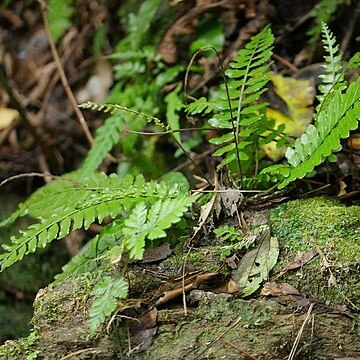Rhizome shortly creeping, up to 3 mm in diam., with 2 or 3 rows of fronds, densely scaly; scales blackish, lanceolate, 2-3 × 1-1.5 mm, opaque or subclathrate, margin with irregular small teeth. Fronds close together; sterile fronds pinnate, 15-40 cm; stipe 5-15 cm, ca. 1 mm in diam., sparsely scaly near base; lamina dark green when dry, lanceolate, 12-25 × 3.5-6 cm, herbaceous; terminal segment triangular, apex acuminate, sometimes somewhat prolonged; rachis usually with a narrow wing; pinnae 15-30 pairs, opposite or alternate, up to 3 cm apart, elliptic-linear, 2-3.5 × 5-8 cm, base asymmetrical, usually oblique, margin ± entire, finely serrate, or lobed to 1/3 toward costa, apex usually obtuse or rounded, lowermost 2 pinnae 1-2 mm stalked; secondary veins on either side with 2 or 3 tertiary veins. Fertile fronds pinnate, 25-40 cm; stipe 20-25 cm; pinnae 10-30 pairs, 8-10 × 2-3 mm, lowermost 2 pinnae 1-9 mm stalked. Sporangia inserted throughout abaxial surface, arrangement fully acrostichoid.
More
Sterile fronds pinnate, 15-100 cm long; lamina index 2-6(-8), 10-80 by 2.5-20 cm, terminal segment 1-10 cm long, herbaceous, usually olivaceous; pinnae (20-)25-60(-85), index 2-5(-7), 1.5-10(-15) by 0.5-2.5 cm, base symmetrical to strongly oblique, margin ± entire, finely serrate, or lobed to ⅓ (1/2) towards the costa; terminal segment triangular, apex sometimes somewhat prolonged; venation pattern: secondary veins on either side with 2 or 3 tertiary veins; see Fig. 27d-f. Fertile fronds 15-90 cm long; pinnae index 1-6, 0.2-11 by 0.15-1.7 cm. Sporangia inserted all over the lower surface or ± restricted to the veins. Spores with a reticulate cristate perispore. Chromosomes n = 41,2n = 82.


